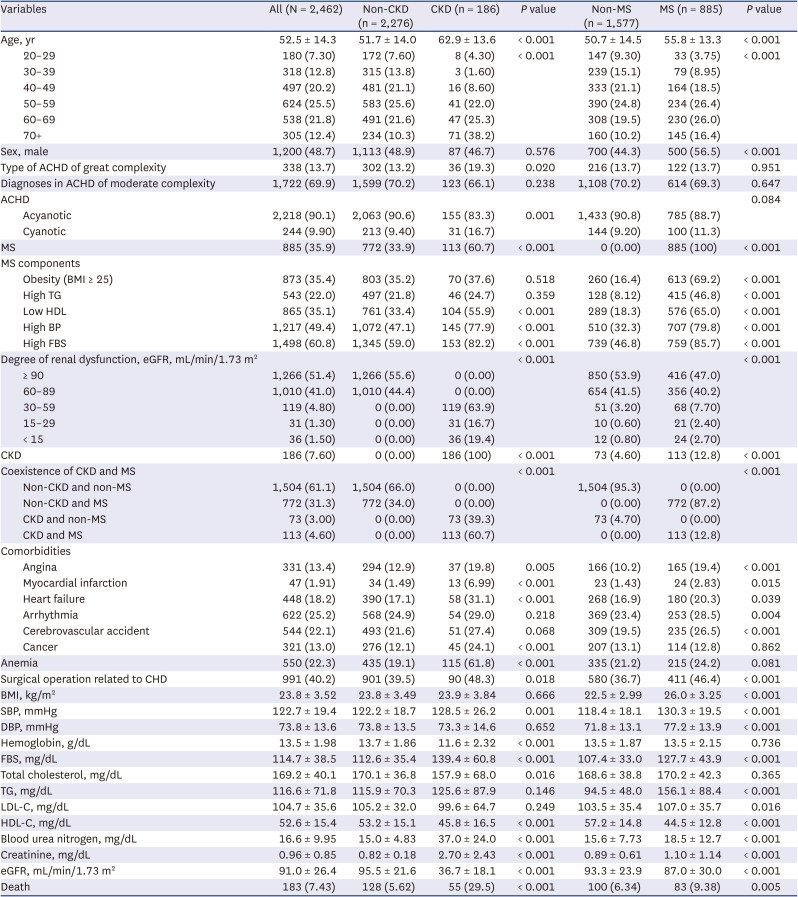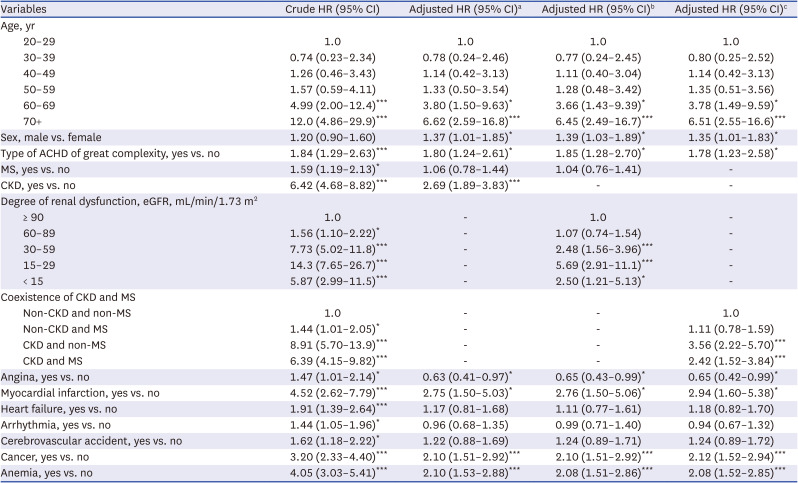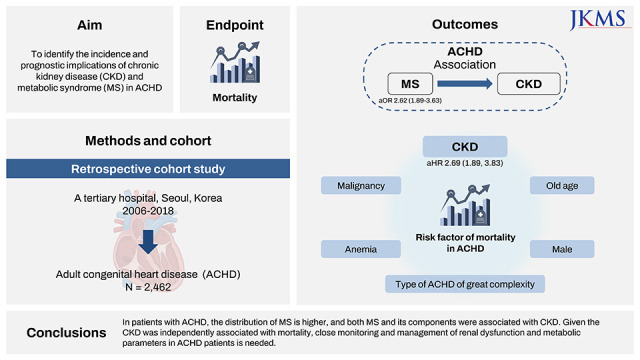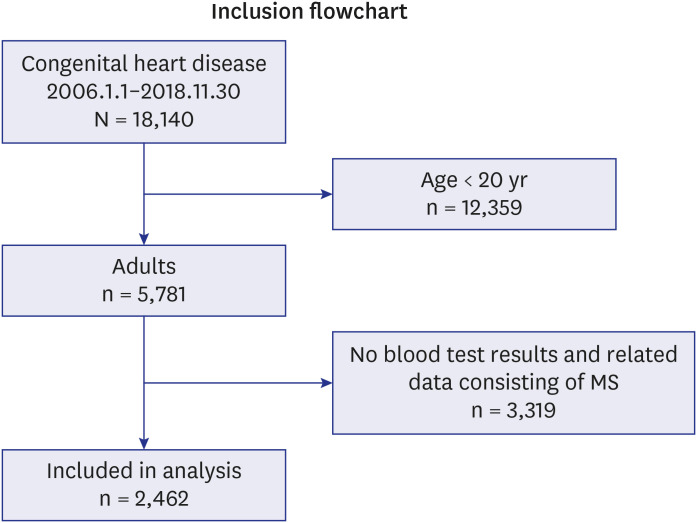1. Lee JS, Jung JM, Choi J, Seo WK, Shin HJ. Major adverse cardiovascular events in Korean congenital heart disease patients: a nationwide age- and sex-matched case-control study. Yonsei Med J. 2022; 63(12):1069–1077. PMID:
36444542.

2. Verheugt CL, Uiterwaal CS, van der Velde ET, Meijboom FJ, Pieper PG, van Dijk AP, et al. Mortality in adult congenital heart disease. Eur Heart J. 2010; 31(10):1220–1229. PMID:
20207625.

3. Tune JD, Goodwill AG, Sassoon DJ, Mather KJ. Cardiovascular consequences of metabolic syndrome. Transl Res. 2017; 183:57–70. PMID:
28130064.

4. Jankowski J, Floege J, Fliser D, Böhm M, Marx N. Cardiovascular disease in chronic kidney disease: pathophysiological insights and therapeutic options. Circulation. 2021; 143(11):1157–1172. PMID:
33720773.
5. Bikbov B, Perico N, Remuzzi G. on behalf of the GBD Genitourinary Diseases Expert Group. Disparities in chronic kidney disease prevalence among males and females in 195 countries: analysis of the Global Burden of Disease 2016 Study. Nephron. 2018; 139(4):313–318. PMID:
29791905.

6. Hill NR, Fatoba ST, Oke JL, Hirst JA, O’Callaghan CA, Lasserson DS, et al. Global prevalence of chronic kidney disease - a systematic review and meta-analysis. PLoS One. 2016; 11(7):e0158765. PMID:
27383068.

7. Mandalenakis Z, Rosengren A, Lappas G, Eriksson P, Hansson PO, Dellborg M. Ischemic stroke in children and young adults with congenital heart disease. J Am Heart Assoc. 2016; 5(2):e003071. PMID:
26908411.

8. Billett J, Cowie MR, Gatzoulis MA, Vonder Muhll IF, Majeed A. Comorbidity, healthcare utilisation and process of care measures in patients with congenital heart disease in the UK: cross-sectional, population-based study with case-control analysis. Heart. 2008; 94(9):1194–1199. PMID:
17646191.

9. Moons P, Van Deyk K, Dedroog D, Troost E, Budts W. Prevalence of cardiovascular risk factors in adults with congenital heart disease. Eur J Cardiovasc Prev Rehabil. 2006; 13(4):612–616. PMID:
16874153.

10. Lee SE, Han K, Kang YM, Kim SO, Cho YK, Ko KS, et al. Trends in the prevalence of metabolic syndrome and its components in South Korea: Findings from the Korean National Health Insurance Service Database (2009-2013). PLoS One. 2018; 13(3):e0194490. PMID:
29566051.

11. Huh JH, Kang DR, Jang JY, Shin JH, Kim JY, Choi S, et al. Metabolic syndrome epidemic among Korean adults: Korean survey of cardiometabolic syndrome (2018). Atherosclerosis. 2018; 277:47–52. PMID:
30172084.

12. Araújo J, Cai J, Stevens J. Prevalence of optimal metabolic health in American adults: National Health and Nutrition Examination Survey 2009-2016. Metab Syndr Relat Disord. 2019; 17(1):46–52. PMID:
30484738.

13. Moore JX, Chaudhary N, Akinyemiju T. Metabolic syndrome prevalence by race/ethnicity and sex in the United States, National Health and Nutrition Examination Survey, 1988-2012. Prev Chronic Dis. 2017; 14:E24. PMID:
28301314.

14. An S, Ahn C, Jang J, Lee J, Kang D, Lee JK, et al. Comparison of the prevalence of cardiometabolic disorders and comorbidities in Korea and the United States: analysis of the National Health and Nutrition Examination Survey. J Korean Med Sci. 2022; 37(18):e149. PMID:
35535376.

15. Izaks GJ, Westendorp RG, Knook DL. The definition of anemia in older persons. JAMA. 1999; 281(18):1714–1717. PMID:
10328071.

16. Warnes CA, Williams RG, Bashore TM, Child JS, Connolly HM, Dearani JA, et al. ACC/AHA 2008 guidelines for the management of adults with congenital heart disease: a report of the American College of Cardiology/American Heart Association Task Force on Practice Guidelines (Writing Committee to Develop Guidelines on the Management of Adults With Congenital Heart Disease). Developed in Collaboration With the American Society of Echocardiography, Heart Rhythm Society, International Society for Adult Congenital Heart Disease, Society for Cardiovascular Angiography and Interventions, and Society of Thoracic Surgeons. J Am Coll Cardiol. 2008; 52(23):e143–e263. PMID:
19038677.
17. Warnes CA, Liberthson R, Danielson GK Jr, Dore A, Harris L, Hoffman JI, et al. Task force 1: the changing profile of congenital heart disease in adult life. J Am Coll Cardiol. 2001; 37(5):1170–1175. PMID:
11300418.

18. Jang SY, Seo SR, Moon JR, Cho EJ, Kim E, Chang SA, et al. Prevalence and mortality of congenital heart disease in Korean adults. Medicine (Baltimore). 2018; 97(27):e11348. PMID:
29979412.

19. Alberti KG, Eckel RH, Grundy SM, Zimmet PZ, Cleeman JI, Donato KA, et al. Harmonizing the metabolic syndrome: a joint interim statement of the International Diabetes Federation Task Force on Epidemiology and Prevention; National Heart, Lung, and Blood Institute; American Heart Association; World Heart Federation; International Atherosclerosis Society; and International Association for the Study of Obesity. Circulation. 2009; 120(16):1640–1645. PMID:
19805654.
21. Morgan C, Al-Aklabi M, Garcia Guerra G. Chronic kidney disease in congenital heart disease patients: a narrative review of evidence. Can J Kidney Health Dis. 2015; 2:27. PMID:
26266042.

22. Dimopoulos K, Diller GP, Koltsida E, Pijuan-Domenech A, Papadopoulou SA, Babu-Narayan SV, et al. Prevalence, predictors, and prognostic value of renal dysfunction in adults with congenital heart disease. Circulation. 2008; 117(18):2320–2328. PMID:
18443238.

23. Vanholder R, Argilés A, Baurmeister U, Brunet P, Clark W, Cohen G, et al. Uremic toxicity: present state of the art. Int J Artif Organs. 2001; 24(10):695–725. PMID:
11817319.

24. Afilalo J, Therrien J, Pilote L, Ionescu-Ittu R, Martucci G, Marelli AJ. Geriatric congenital heart disease: burden of disease and predictors of mortality. J Am Coll Cardiol. 2011; 58(14):1509–1515. PMID:
21939837.
25. Jang SY, Kim IH, Ju EY, Ahn SJ, Kim DK, Lee SW. Chronic kidney disease and metabolic syndrome in a general Korean population: the third Korea National Health and Nutrition Examination Survey (KNHANES III) study. J Public Health (Oxf). 2010; 32(4):538–546. PMID:
20061374.

26. Moon JR, Song J, Huh J, Kang IS, Park SW, Chang SA, et al. Analysis of cardiovascular risk factors in adults with congenital heart disease. Korean Circ J. 2015; 45(5):416–423. PMID:
26413110.

27. Deen JF, Krieger EV, Slee AE, Arslan A, Arterburn D, Stout KK, et al. Metabolic syndrome in adults with congenital heart disease. J Am Heart Assoc. 2016; 5(2):e001132. PMID:
26873680.

28. Niwa K. Metabolic syndrome in adult congenital heart disease. Korean Circ J. 2019; 49(8):691–708. PMID:
31347322.

29. Lavie CJ, De Schutter A, Parto P, Jahangir E, Kokkinos P, Ortega FB, et al. Obesity and prevalence of cardiovascular diseases and prognosis-the obesity paradox updated. Prog Cardiovasc Dis. 2016; 58(5):537–547. PMID:
26826295.

30. Elagizi A, Kachur S, Lavie CJ, Carbone S, Pandey A, Ortega FB, et al. An overview and update on obesity and the obesity paradox in cardiovascular diseases. Prog Cardiovasc Dis. 2018; 61(2):142–150. PMID:
29981771.

31. Carbone S, Canada JM, Billingsley HE, Siddiqui MS, Elagizi A, Lavie CJ. Obesity paradox in cardiovascular disease: where do we stand? Vasc Health Risk Manag. 2019; 15:89–100. PMID:
31118651.
32. Brida M, Dimopoulos K, Kempny A, Liodakis E, Alonso-Gonzalez R, Swan L, et al. Body mass index in adult congenital heart disease. Heart. 2017; 103(16):1250–1257. PMID:
28237971.

33. Olsen M, Marino B, Kaltman J, Laursen H, Jakobsen L, Mahle W, et al. Myocardial infarction in adults with congenital heart disease. Am J Cardiol. 2017; 120(12):2272–2277. PMID:
29111211.

34. Fedchenko M, Mandalenakis Z, Rosengren A, Lappas G, Eriksson P, Skoglund K, et al. Ischemic heart disease in children and young adults with congenital heart disease in Sweden. Int J Cardiol. 2017; 248:143–148. PMID:
28705603.

35. Venkatesh P, Yan KL, Bravo-Jaimes K, Yang EH, Lluri G. Outcomes of malignancy in adults with congenital heart disease: a single center experience. Cardiooncology. 2022; 8(1):20. PMID:
36419184.

36. Mandalenakis Z, Karazisi C, Skoglund K, Rosengren A, Lappas G, Eriksson P, et al. Risk of cancer among children and young adults with congenital heart disease compared with healthy controls. JAMA Netw Open. 2019; 2(7):e196762. PMID:
31276179.

37. Olsen M, Garne E, Sværke C, Søndergaard L, Nissen H, Andersen HO, et al. Cancer risk among patients with congenital heart defects: a nationwide follow-up study. Cardiol Young. 2014; 24(1):40–46. PMID:
23328503.

38. Fedchenko M, Mandalenakis Z, Giang KW, Rosengren A, Eriksson P, Dellborg M. Long-term outcomes after myocardial infarction in middle-aged and older patients with congenital heart disease-a nationwide study. Eur Heart J. 2021; 42(26):2577–2586. PMID:
33219678.

39. Lee YS, Chen YT, Jeng MJ, Tsao PC, Yen HJ, Lee PC, et al. The risk of cancer in patients with congenital heart disease: a nationwide population-based cohort study in Taiwan. PLoS One. 2015; 10(2):e0116844. PMID:
25706872.








 PDF
PDF Citation
Citation Print
Print





 XML Download
XML Download